Finance for Project Managers (ACC372): HS2 Project Appraisal
VerifiedAdded on 2021/07/20
|27
|6756
|93
Report
AI Summary
This report provides a critical appraisal of the HS2 project, commissioned by the Department of Transport and managed by HS2 LTD, evaluating its financial viability and project management practices. The report examines key variables such as funding, budget and cost controls, investment appraisal, provider selection, procurement, and sustainability, referencing the PRINCE2 methodology. It highlights significant concerns regarding budget overruns, funding discrepancies, and the application of financial metrics. The report further analyzes investment appraisal techniques used, such as sensitivity analysis, and critiques the project's communication with stakeholders. It concludes by offering recommendations for improved project management and financial control, emphasizing the need for better decision-making, risk management, and adherence to PRINCE2 principles to mitigate potential disasters and ensure the project's success. The report also addresses the environmental impacts and stakeholder concerns, and emphasizes the importance of learning from past project decisions.
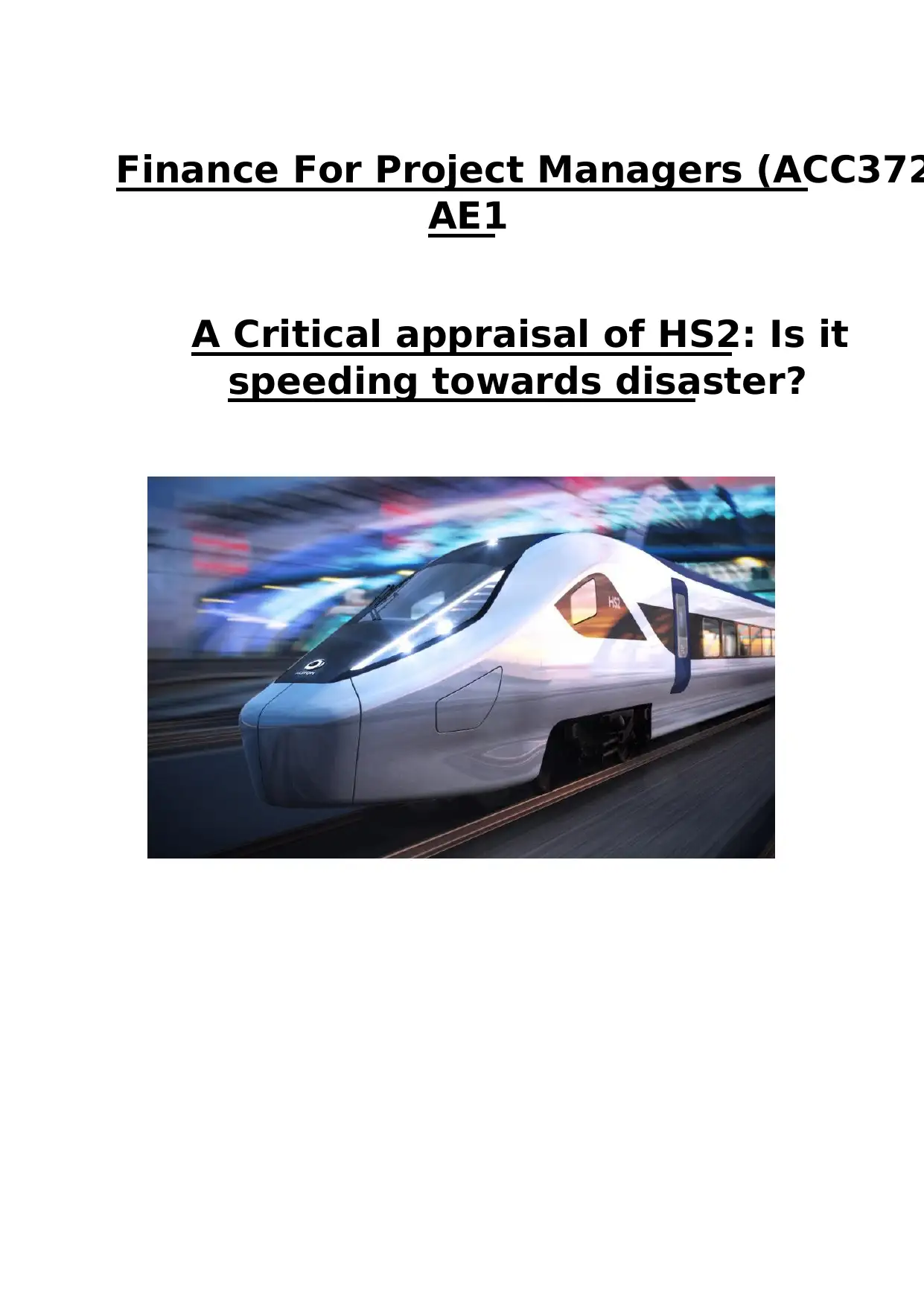
Finance For Project Managers (ACC372
AE1
A Critical appraisal of HS2: Is it
speeding towards disaster?
AE1
A Critical appraisal of HS2: Is it
speeding towards disaster?
Paraphrase This Document
Need a fresh take? Get an instant paraphrase of this document with our AI Paraphraser
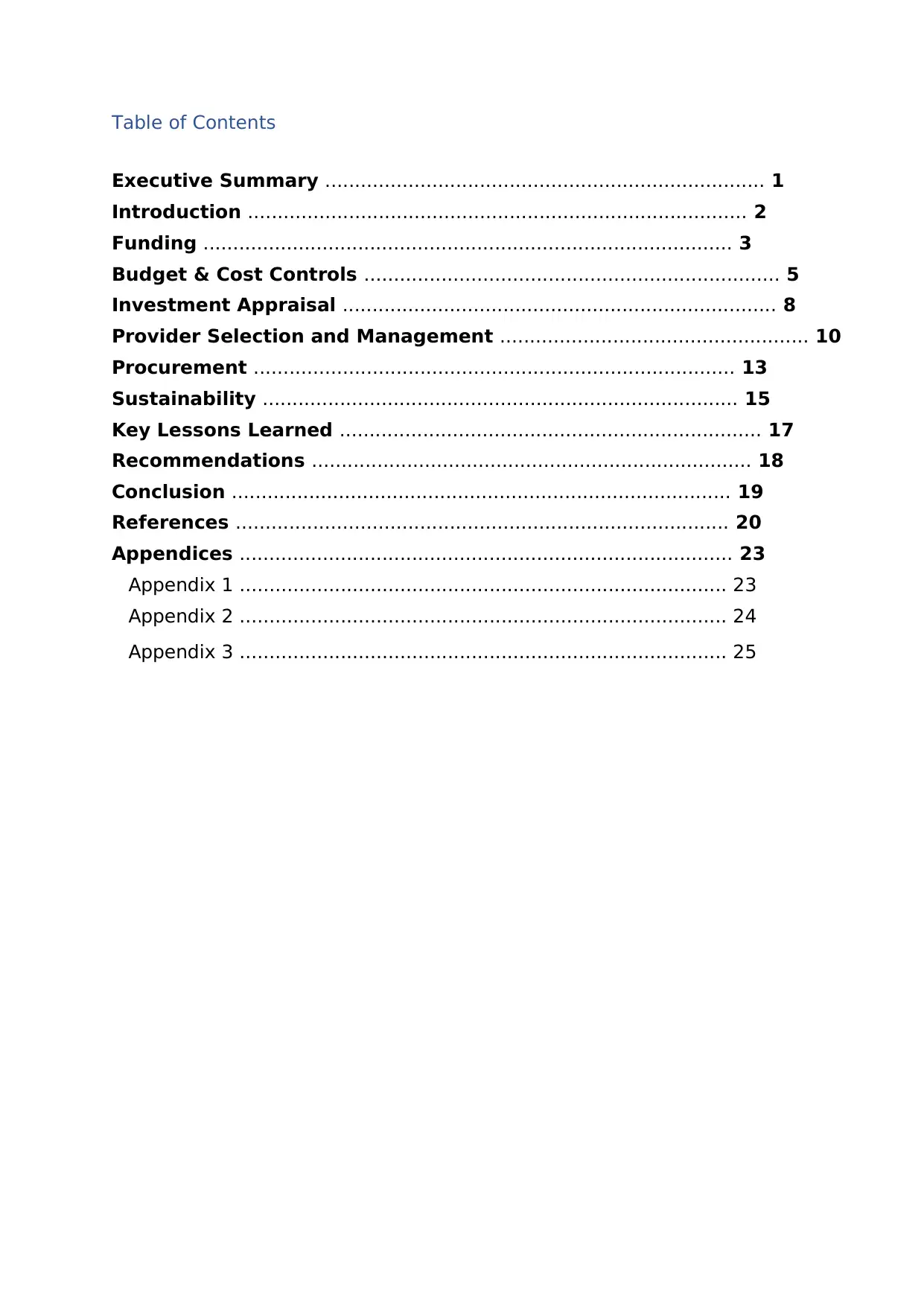
Table of Contents
Executive Summary .......................................................................... 1
Introduction .................................................................................... 2
Funding ......................................................................................... 3
Budget & Cost Controls ...................................................................... 5
Investment Appraisal ......................................................................... 8
Provider Selection and Management .................................................... 10
Procurement ................................................................................. 13
Sustainability ................................................................................ 15
Key Lessons Learned ....................................................................... 17
Recommendations .......................................................................... 18
Conclusion .................................................................................... 19
References ................................................................................... 20
Appendices ................................................................................... 23
Appendix 1 .................................................................................. 23
Appendix 2 .................................................................................. 24
Appendix 3 .................................................................................. 25
Executive Summary .......................................................................... 1
Introduction .................................................................................... 2
Funding ......................................................................................... 3
Budget & Cost Controls ...................................................................... 5
Investment Appraisal ......................................................................... 8
Provider Selection and Management .................................................... 10
Procurement ................................................................................. 13
Sustainability ................................................................................ 15
Key Lessons Learned ....................................................................... 17
Recommendations .......................................................................... 18
Conclusion .................................................................................... 19
References ................................................................................... 20
Appendices ................................................................................... 23
Appendix 1 .................................................................................. 23
Appendix 2 .................................................................................. 24
Appendix 3 .................................................................................. 25
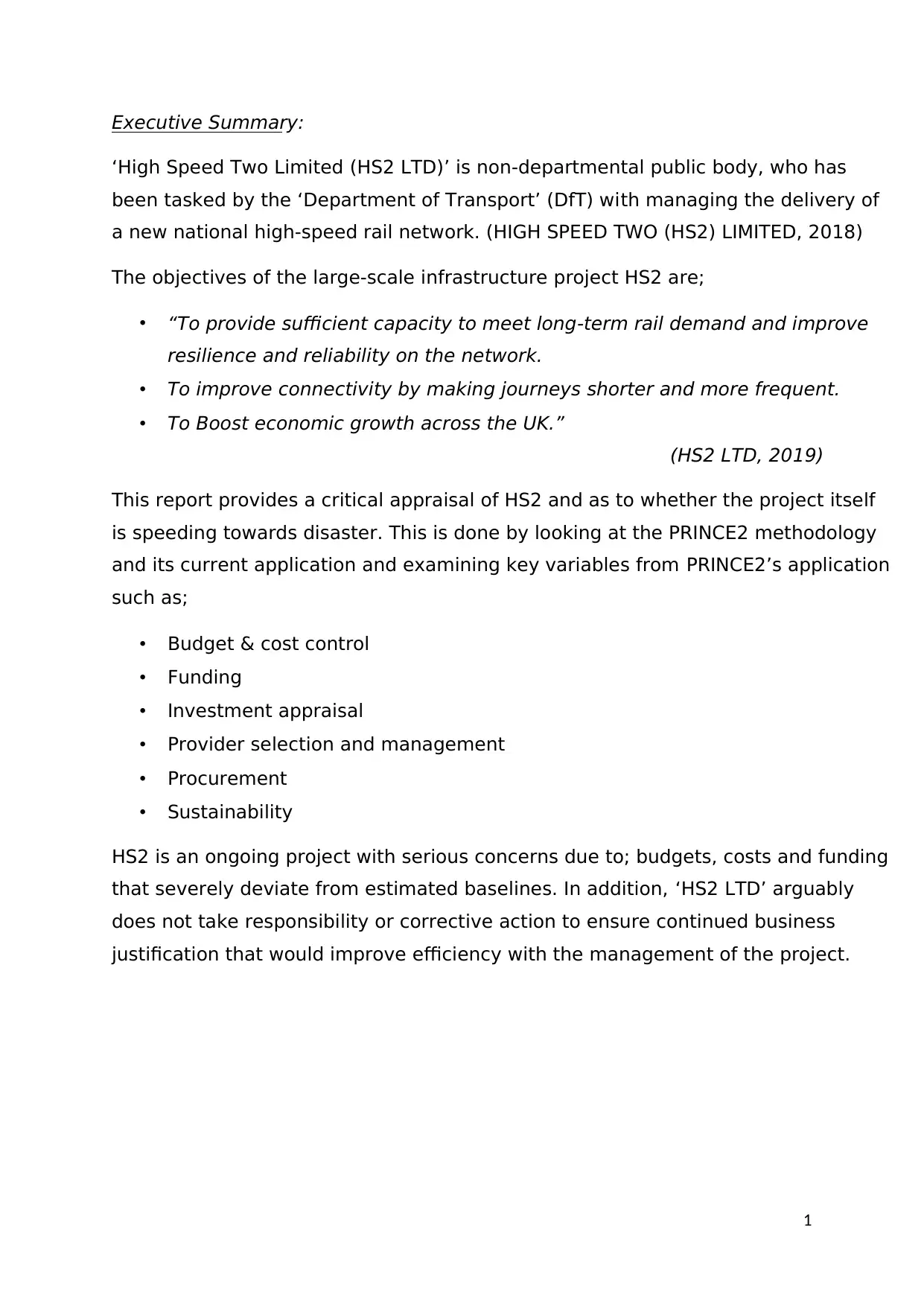
1
Executive Summary:
‘High Speed Two Limited (HS2 LTD)’ is non-departmental public body, who has
been tasked by the ‘Department of Transport’ (DfT) with managing the delivery of
a new national high-speed rail network. (HIGH SPEED TWO (HS2) LIMITED, 2018)
The objectives of the large-scale infrastructure project HS2 are;
• “To provide sufficient capacity to meet long-term rail demand and improve
resilience and reliability on the network.
• To improve connectivity by making journeys shorter and more frequent.
• To Boost economic growth across the UK.”
(HS2 LTD, 2019)
This report provides a critical appraisal of HS2 and as to whether the project itself
is speeding towards disaster. This is done by looking at the PRINCE2 methodology
and its current application and examining key variables from PRINCE2’s application
such as;
• Budget & cost control
• Funding
• Investment appraisal
• Provider selection and management
• Procurement
• Sustainability
HS2 is an ongoing project with serious concerns due to; budgets, costs and funding
that severely deviate from estimated baselines. In addition, ‘HS2 LTD’ arguably
does not take responsibility or corrective action to ensure continued business
justification that would improve efficiency with the management of the project.
Executive Summary:
‘High Speed Two Limited (HS2 LTD)’ is non-departmental public body, who has
been tasked by the ‘Department of Transport’ (DfT) with managing the delivery of
a new national high-speed rail network. (HIGH SPEED TWO (HS2) LIMITED, 2018)
The objectives of the large-scale infrastructure project HS2 are;
• “To provide sufficient capacity to meet long-term rail demand and improve
resilience and reliability on the network.
• To improve connectivity by making journeys shorter and more frequent.
• To Boost economic growth across the UK.”
(HS2 LTD, 2019)
This report provides a critical appraisal of HS2 and as to whether the project itself
is speeding towards disaster. This is done by looking at the PRINCE2 methodology
and its current application and examining key variables from PRINCE2’s application
such as;
• Budget & cost control
• Funding
• Investment appraisal
• Provider selection and management
• Procurement
• Sustainability
HS2 is an ongoing project with serious concerns due to; budgets, costs and funding
that severely deviate from estimated baselines. In addition, ‘HS2 LTD’ arguably
does not take responsibility or corrective action to ensure continued business
justification that would improve efficiency with the management of the project.
⊘ This is a preview!⊘
Do you want full access?
Subscribe today to unlock all pages.

Trusted by 1+ million students worldwide

2
Introduction:
The aim of this report is to provide a critical appraisal of the HS2 project. This has
been done by analysing the key variables and evaluating issues project managers
on the project have experienced. As well as looking at how the PRINCE2
methodology has already and, can be further applied to management of the
project to deliver on objectives. Thus, enabling a clear analysis of the lessons
learned relating to the project delivery and how these lessons would assist
managers of future large-scale projects.
HS2 is a highspeed rail project inspired by ‘Tōkaidō Shinkansen’. TOPHAM (2019)
states “the project was officially launched in 2009, was tweaked by the coalition
government and greenlighted in 2012 as a Y shaped network”. This allows
passengers to travel between the city centres of London, Birmingham, Manchester,
and Leeds at up to speeds of 250mph, reducing journey times, supporting job
growth & accessibility, all whilst providing a low carbon method of travel,
supporting the transition to a net-zero carbon Britain. HS2 will be completed in
multiple phases; Phase 1, Phase 2A & Phase 2B.
Limitations of research can be seen in appendix 1.
Introduction:
The aim of this report is to provide a critical appraisal of the HS2 project. This has
been done by analysing the key variables and evaluating issues project managers
on the project have experienced. As well as looking at how the PRINCE2
methodology has already and, can be further applied to management of the
project to deliver on objectives. Thus, enabling a clear analysis of the lessons
learned relating to the project delivery and how these lessons would assist
managers of future large-scale projects.
HS2 is a highspeed rail project inspired by ‘Tōkaidō Shinkansen’. TOPHAM (2019)
states “the project was officially launched in 2009, was tweaked by the coalition
government and greenlighted in 2012 as a Y shaped network”. This allows
passengers to travel between the city centres of London, Birmingham, Manchester,
and Leeds at up to speeds of 250mph, reducing journey times, supporting job
growth & accessibility, all whilst providing a low carbon method of travel,
supporting the transition to a net-zero carbon Britain. HS2 will be completed in
multiple phases; Phase 1, Phase 2A & Phase 2B.
Limitations of research can be seen in appendix 1.
Paraphrase This Document
Need a fresh take? Get an instant paraphrase of this document with our AI Paraphraser
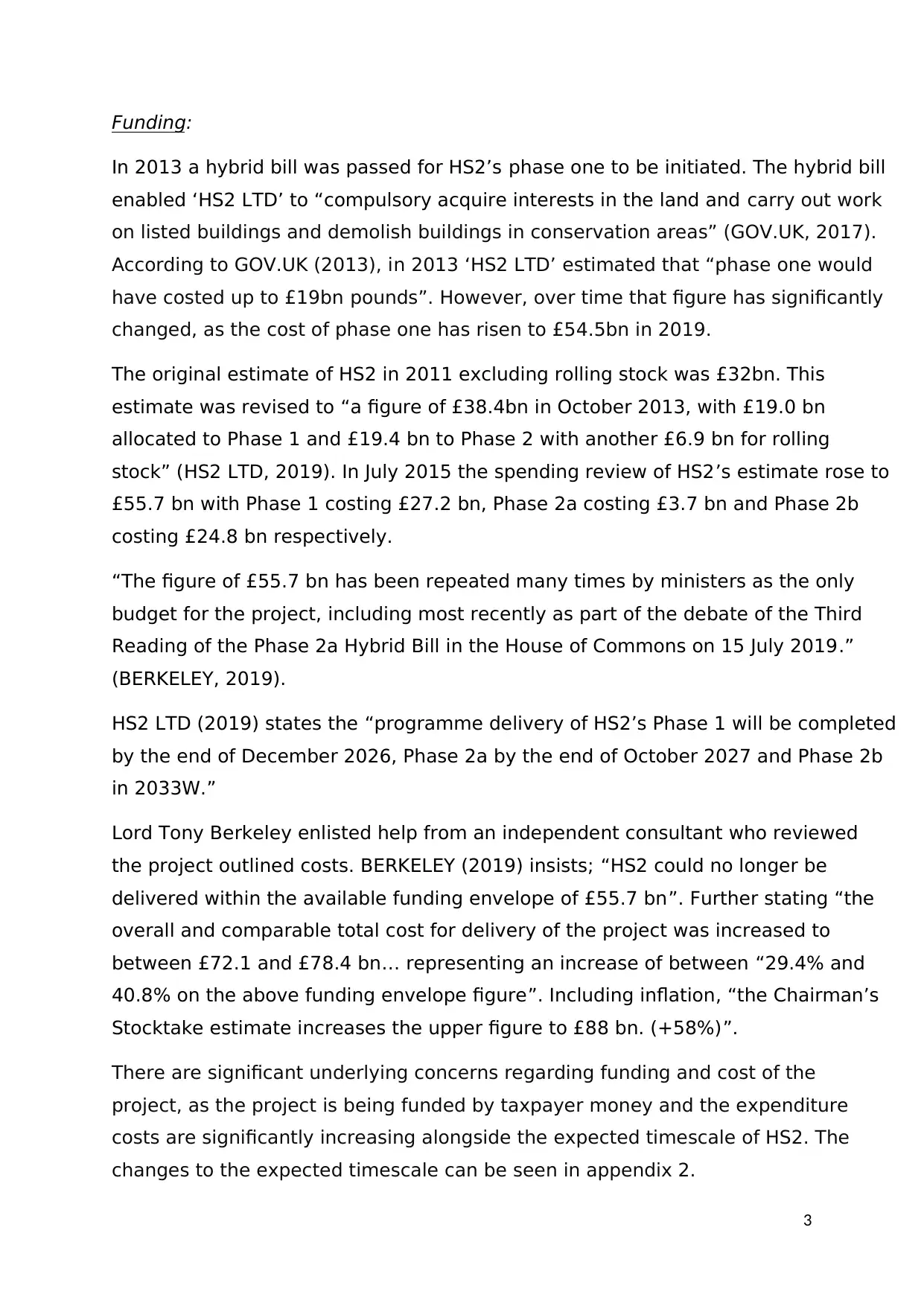
3
Funding:
In 2013 a hybrid bill was passed for HS2’s phase one to be initiated. The hybrid bill
enabled ‘HS2 LTD’ to “compulsory acquire interests in the land and carry out work
on listed buildings and demolish buildings in conservation areas” (GOV.UK, 2017).
According to GOV.UK (2013), in 2013 ‘HS2 LTD’ estimated that “phase one would
have costed up to £19bn pounds”. However, over time that figure has significantly
changed, as the cost of phase one has risen to £54.5bn in 2019.
The original estimate of HS2 in 2011 excluding rolling stock was £32bn. This
estimate was revised to “a figure of £38.4bn in October 2013, with £19.0 bn
allocated to Phase 1 and £19.4 bn to Phase 2 with another £6.9 bn for rolling
stock” (HS2 LTD, 2019). In July 2015 the spending review of HS2’s estimate rose to
£55.7 bn with Phase 1 costing £27.2 bn, Phase 2a costing £3.7 bn and Phase 2b
costing £24.8 bn respectively.
“The figure of £55.7 bn has been repeated many times by ministers as the only
budget for the project, including most recently as part of the debate of the Third
Reading of the Phase 2a Hybrid Bill in the House of Commons on 15 July 2019.”
(BERKELEY, 2019).
HS2 LTD (2019) states the “programme delivery of HS2’s Phase 1 will be completed
by the end of December 2026, Phase 2a by the end of October 2027 and Phase 2b
in 2033W.”
Lord Tony Berkeley enlisted help from an independent consultant who reviewed
the project outlined costs. BERKELEY (2019) insists; “HS2 could no longer be
delivered within the available funding envelope of £55.7 bn”. Further stating “the
overall and comparable total cost for delivery of the project was increased to
between £72.1 and £78.4 bn… representing an increase of between “29.4% and
40.8% on the above funding envelope figure”. Including inflation, “the Chairman’s
Stocktake estimate increases the upper figure to £88 bn. (+58%)”.
There are significant underlying concerns regarding funding and cost of the
project, as the project is being funded by taxpayer money and the expenditure
costs are significantly increasing alongside the expected timescale of HS2. The
changes to the expected timescale can be seen in appendix 2.
Funding:
In 2013 a hybrid bill was passed for HS2’s phase one to be initiated. The hybrid bill
enabled ‘HS2 LTD’ to “compulsory acquire interests in the land and carry out work
on listed buildings and demolish buildings in conservation areas” (GOV.UK, 2017).
According to GOV.UK (2013), in 2013 ‘HS2 LTD’ estimated that “phase one would
have costed up to £19bn pounds”. However, over time that figure has significantly
changed, as the cost of phase one has risen to £54.5bn in 2019.
The original estimate of HS2 in 2011 excluding rolling stock was £32bn. This
estimate was revised to “a figure of £38.4bn in October 2013, with £19.0 bn
allocated to Phase 1 and £19.4 bn to Phase 2 with another £6.9 bn for rolling
stock” (HS2 LTD, 2019). In July 2015 the spending review of HS2’s estimate rose to
£55.7 bn with Phase 1 costing £27.2 bn, Phase 2a costing £3.7 bn and Phase 2b
costing £24.8 bn respectively.
“The figure of £55.7 bn has been repeated many times by ministers as the only
budget for the project, including most recently as part of the debate of the Third
Reading of the Phase 2a Hybrid Bill in the House of Commons on 15 July 2019.”
(BERKELEY, 2019).
HS2 LTD (2019) states the “programme delivery of HS2’s Phase 1 will be completed
by the end of December 2026, Phase 2a by the end of October 2027 and Phase 2b
in 2033W.”
Lord Tony Berkeley enlisted help from an independent consultant who reviewed
the project outlined costs. BERKELEY (2019) insists; “HS2 could no longer be
delivered within the available funding envelope of £55.7 bn”. Further stating “the
overall and comparable total cost for delivery of the project was increased to
between £72.1 and £78.4 bn… representing an increase of between “29.4% and
40.8% on the above funding envelope figure”. Including inflation, “the Chairman’s
Stocktake estimate increases the upper figure to £88 bn. (+58%)”.
There are significant underlying concerns regarding funding and cost of the
project, as the project is being funded by taxpayer money and the expenditure
costs are significantly increasing alongside the expected timescale of HS2. The
changes to the expected timescale can be seen in appendix 2.

4
Lord Tony Berkeley who is a member of the house of lords and Labour Party
transport spokesperson has published his own review of HS2 raising awareness to
the project’s actual performance & underlying issues and concerns.
Suggesting HS2 is not financially viable nor provides the benefits promised. Such as
economic regeneration, BERKELEY (2019) states “there is no evidence that this
would not come from improved local and regional rail services as opposed to those
which enable faster journeys to or from London”. This is because NPH (Nothern
Powerhouse) & MC (Midlands Connect) lines would only benefit, as HS2 benefits the
northside of the UK’s travel more, when research conducted by South West Rail
suggests that the south is more desperate need.
In addition, concerns over the environment and how the “situation has been
exacerbated by the appalling treatment of stakeholders, residents, businesses &
councils in areas over which it plans to construct the lines” (BERKELEY, 2019).
Lord Tony Berkeley who is a member of the house of lords and Labour Party
transport spokesperson has published his own review of HS2 raising awareness to
the project’s actual performance & underlying issues and concerns.
Suggesting HS2 is not financially viable nor provides the benefits promised. Such as
economic regeneration, BERKELEY (2019) states “there is no evidence that this
would not come from improved local and regional rail services as opposed to those
which enable faster journeys to or from London”. This is because NPH (Nothern
Powerhouse) & MC (Midlands Connect) lines would only benefit, as HS2 benefits the
northside of the UK’s travel more, when research conducted by South West Rail
suggests that the south is more desperate need.
In addition, concerns over the environment and how the “situation has been
exacerbated by the appalling treatment of stakeholders, residents, businesses &
councils in areas over which it plans to construct the lines” (BERKELEY, 2019).
⊘ This is a preview!⊘
Do you want full access?
Subscribe today to unlock all pages.

Trusted by 1+ million students worldwide

5
Budget & Cost Controls:
According to UNITED STATES GAO (2000) poorly managed projects usually are
results of a “focus on designing projects and obtaining funding and focused less on
developing a practical plan for managing and constructing a project effectively
once funding was received”.
The ‘Lee Merkhofer’ approach argues that up to “20-40% of available value from
business is lost due to errors in decision making and weaknesses in business
systems” (Wideman, 2004). Therefore, it can be perceived that by making more
suitable decisions, value can increase without costs increasing or bring a decrease
in cost all together. Wideman (2004) states the reasons for these poor decisions
derive from;
• “Errors and Bias in Judgement
• Failure to see the forest for the trees (See the bigger picture in regards
to programme/portfolio)
• Lack of right financial metrics
• Inadequate attention to risk”
‘HS2 LTD’ has been heavily criticised for their decision making, poor financial
management & risk management. In Panorama's episode HS2: Going off the rails
(2018), Doug Thornton the Former land and property director of ‘HS2 LTD’ stated
when he joined, he found early estimates were still in use, due to a ‘desk based
approach’ being used. Implying that they were overly optimistic and not realistic
considering the current economic climate, external influences and associated risks.
An example Doug Thornton raised was “under-estimates occurring on procurement
of buildings”. As HS2 purchased up to over 6,000 houses over the estimate
provided and with up to £100-200k difference in smaller buildings, complex
buildings being millions of pounds spent overestimate.
A financial metric that would benefit ‘HS2 LTD’ in regard to their decision making
for future projects would be to use the ‘Efficient Frontier’. INVESTOPEDIA (2019)
states the “Efficient frontier comprises investment portfolios that offer the highest
expected return for a specific level of risk…with optimal portfolios that comprise
the efficient frontier tend to have a higher degree of diversification”. This
Budget & Cost Controls:
According to UNITED STATES GAO (2000) poorly managed projects usually are
results of a “focus on designing projects and obtaining funding and focused less on
developing a practical plan for managing and constructing a project effectively
once funding was received”.
The ‘Lee Merkhofer’ approach argues that up to “20-40% of available value from
business is lost due to errors in decision making and weaknesses in business
systems” (Wideman, 2004). Therefore, it can be perceived that by making more
suitable decisions, value can increase without costs increasing or bring a decrease
in cost all together. Wideman (2004) states the reasons for these poor decisions
derive from;
• “Errors and Bias in Judgement
• Failure to see the forest for the trees (See the bigger picture in regards
to programme/portfolio)
• Lack of right financial metrics
• Inadequate attention to risk”
‘HS2 LTD’ has been heavily criticised for their decision making, poor financial
management & risk management. In Panorama's episode HS2: Going off the rails
(2018), Doug Thornton the Former land and property director of ‘HS2 LTD’ stated
when he joined, he found early estimates were still in use, due to a ‘desk based
approach’ being used. Implying that they were overly optimistic and not realistic
considering the current economic climate, external influences and associated risks.
An example Doug Thornton raised was “under-estimates occurring on procurement
of buildings”. As HS2 purchased up to over 6,000 houses over the estimate
provided and with up to £100-200k difference in smaller buildings, complex
buildings being millions of pounds spent overestimate.
A financial metric that would benefit ‘HS2 LTD’ in regard to their decision making
for future projects would be to use the ‘Efficient Frontier’. INVESTOPEDIA (2019)
states the “Efficient frontier comprises investment portfolios that offer the highest
expected return for a specific level of risk…with optimal portfolios that comprise
the efficient frontier tend to have a higher degree of diversification”. This
Paraphrase This Document
Need a fresh take? Get an instant paraphrase of this document with our AI Paraphraser

6
financial metric enables businesses and project managers to look at financial
decisions that best suit their own tolerance levels and provide the best expected
return alongside it. “As project managers better understand the link between their
project designs and the value derived by the organisation, they create better
project proposals” (Wideman 2004).
HS2 LTD’s recent publication HS2 LTD (2019) state they “use their risk budget to
counteract early immaturity in setting budgets and monitoring risk”. This approach
in retrospect has costed them significantly and has resulted in estimation and
existing costs to increase exponentially as previously mentioned.
‘HS2 LTD’ go further admitting due to the “scale and complexity of HS2, it makes
the process even more challenging than for other large-scale projects” (HS2,
2019).
Although managing large scale infrastructure projects is no easy task, using the
right “innovative tools to improve on the performance of the planning process can
help manage budgets and decision making” (FLYVBERG et al, 2008).
PRINCE2’s recommended risk management procedure is a reliable way in which to
“Identify, Assess, Plan, Implement & communicate risk” (PRINCE2, 2017). The fifth
step ‘communicate’ operates in parallel with all other steps as information would
need to be communicated to stakeholders through a project. “All steps are
repeatable when new information becomes available, as it is necessary to re-
evaluate.” (MURRAY-WEBSTER, 2010)
A change budget is required for any project, especially now for HS2. As changes in
expenditure are constantly occurring and HS2 have an arguable ‘laissez faire’
approach. Making changes without considering the economical impact on the UK.
Using a PRINCE2 approach and continued business justification & learning from
experience principles, an in-depth change control approach needs to be applied.
“Identifying issues and how they are managed and assessing whether issues
identified have material impact on the business justification... further using
lessons learned” from previous projects and decisions (PRINCE2, 2017). The reason
financial metric enables businesses and project managers to look at financial
decisions that best suit their own tolerance levels and provide the best expected
return alongside it. “As project managers better understand the link between their
project designs and the value derived by the organisation, they create better
project proposals” (Wideman 2004).
HS2 LTD’s recent publication HS2 LTD (2019) state they “use their risk budget to
counteract early immaturity in setting budgets and monitoring risk”. This approach
in retrospect has costed them significantly and has resulted in estimation and
existing costs to increase exponentially as previously mentioned.
‘HS2 LTD’ go further admitting due to the “scale and complexity of HS2, it makes
the process even more challenging than for other large-scale projects” (HS2,
2019).
Although managing large scale infrastructure projects is no easy task, using the
right “innovative tools to improve on the performance of the planning process can
help manage budgets and decision making” (FLYVBERG et al, 2008).
PRINCE2’s recommended risk management procedure is a reliable way in which to
“Identify, Assess, Plan, Implement & communicate risk” (PRINCE2, 2017). The fifth
step ‘communicate’ operates in parallel with all other steps as information would
need to be communicated to stakeholders through a project. “All steps are
repeatable when new information becomes available, as it is necessary to re-
evaluate.” (MURRAY-WEBSTER, 2010)
A change budget is required for any project, especially now for HS2. As changes in
expenditure are constantly occurring and HS2 have an arguable ‘laissez faire’
approach. Making changes without considering the economical impact on the UK.
Using a PRINCE2 approach and continued business justification & learning from
experience principles, an in-depth change control approach needs to be applied.
“Identifying issues and how they are managed and assessing whether issues
identified have material impact on the business justification... further using
lessons learned” from previous projects and decisions (PRINCE2, 2017). The reason

7
for this is try and help costs remain within these new revised funding budgets, to
help reaffirm confidence within the project and to stakeholders involved.
for this is try and help costs remain within these new revised funding budgets, to
help reaffirm confidence within the project and to stakeholders involved.
⊘ This is a preview!⊘
Do you want full access?
Subscribe today to unlock all pages.

Trusted by 1+ million students worldwide
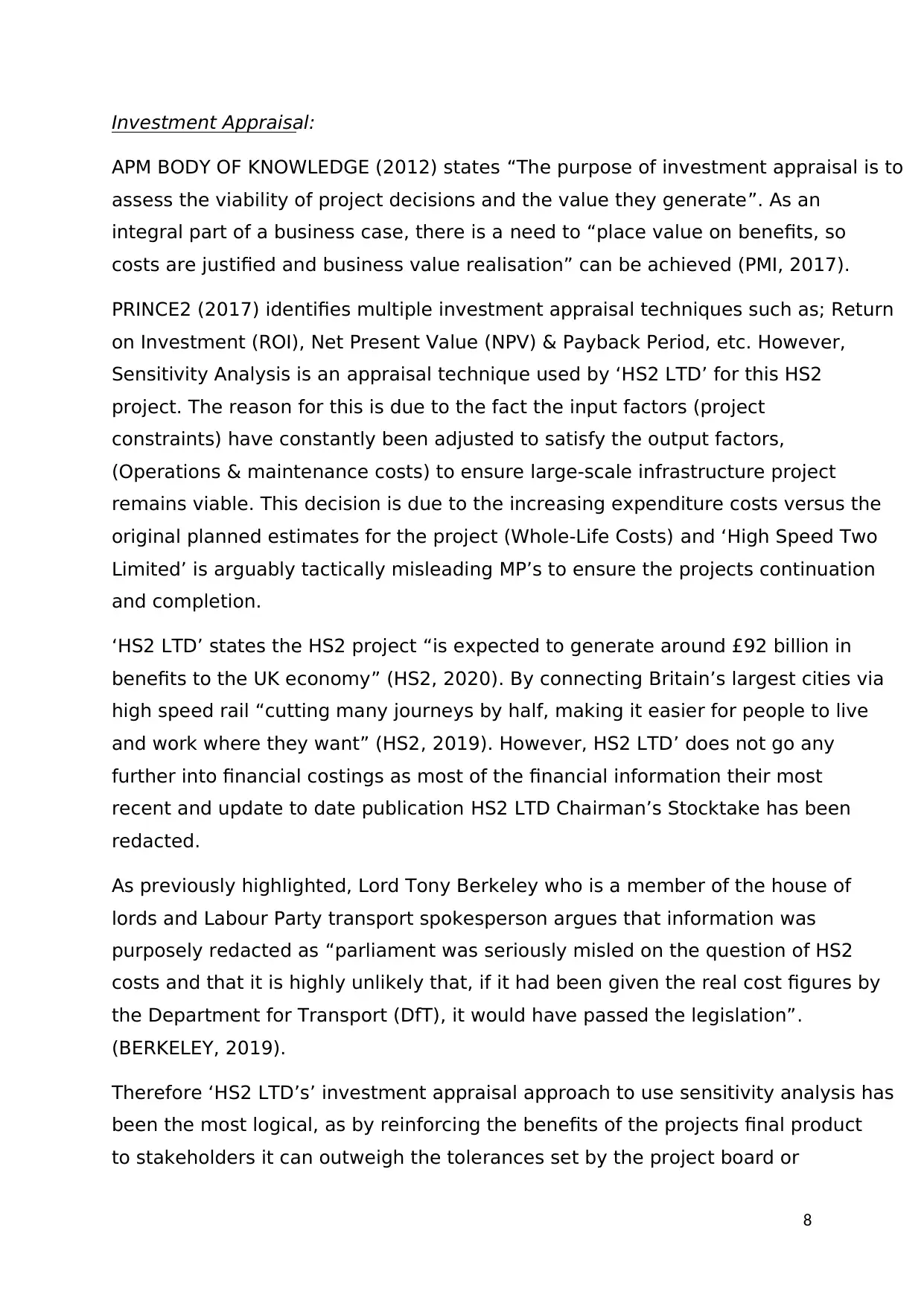
8
Investment Appraisal:
APM BODY OF KNOWLEDGE (2012) states “The purpose of investment appraisal is to
assess the viability of project decisions and the value they generate”. As an
integral part of a business case, there is a need to “place value on benefits, so
costs are justified and business value realisation” can be achieved (PMI, 2017).
PRINCE2 (2017) identifies multiple investment appraisal techniques such as; Return
on Investment (ROI), Net Present Value (NPV) & Payback Period, etc. However,
Sensitivity Analysis is an appraisal technique used by ‘HS2 LTD’ for this HS2
project. The reason for this is due to the fact the input factors (project
constraints) have constantly been adjusted to satisfy the output factors,
(Operations & maintenance costs) to ensure large-scale infrastructure project
remains viable. This decision is due to the increasing expenditure costs versus the
original planned estimates for the project (Whole-Life Costs) and ‘High Speed Two
Limited’ is arguably tactically misleading MP’s to ensure the projects continuation
and completion.
‘HS2 LTD’ states the HS2 project “is expected to generate around £92 billion in
benefits to the UK economy” (HS2, 2020). By connecting Britain’s largest cities via
high speed rail “cutting many journeys by half, making it easier for people to live
and work where they want” (HS2, 2019). However, HS2 LTD’ does not go any
further into financial costings as most of the financial information their most
recent and update to date publication HS2 LTD Chairman’s Stocktake has been
redacted.
As previously highlighted, Lord Tony Berkeley who is a member of the house of
lords and Labour Party transport spokesperson argues that information was
purposely redacted as “parliament was seriously misled on the question of HS2
costs and that it is highly unlikely that, if it had been given the real cost figures by
the Department for Transport (DfT), it would have passed the legislation”.
(BERKELEY, 2019).
Therefore ‘HS2 LTD’s’ investment appraisal approach to use sensitivity analysis has
been the most logical, as by reinforcing the benefits of the projects final product
to stakeholders it can outweigh the tolerances set by the project board or
Investment Appraisal:
APM BODY OF KNOWLEDGE (2012) states “The purpose of investment appraisal is to
assess the viability of project decisions and the value they generate”. As an
integral part of a business case, there is a need to “place value on benefits, so
costs are justified and business value realisation” can be achieved (PMI, 2017).
PRINCE2 (2017) identifies multiple investment appraisal techniques such as; Return
on Investment (ROI), Net Present Value (NPV) & Payback Period, etc. However,
Sensitivity Analysis is an appraisal technique used by ‘HS2 LTD’ for this HS2
project. The reason for this is due to the fact the input factors (project
constraints) have constantly been adjusted to satisfy the output factors,
(Operations & maintenance costs) to ensure large-scale infrastructure project
remains viable. This decision is due to the increasing expenditure costs versus the
original planned estimates for the project (Whole-Life Costs) and ‘High Speed Two
Limited’ is arguably tactically misleading MP’s to ensure the projects continuation
and completion.
‘HS2 LTD’ states the HS2 project “is expected to generate around £92 billion in
benefits to the UK economy” (HS2, 2020). By connecting Britain’s largest cities via
high speed rail “cutting many journeys by half, making it easier for people to live
and work where they want” (HS2, 2019). However, HS2 LTD’ does not go any
further into financial costings as most of the financial information their most
recent and update to date publication HS2 LTD Chairman’s Stocktake has been
redacted.
As previously highlighted, Lord Tony Berkeley who is a member of the house of
lords and Labour Party transport spokesperson argues that information was
purposely redacted as “parliament was seriously misled on the question of HS2
costs and that it is highly unlikely that, if it had been given the real cost figures by
the Department for Transport (DfT), it would have passed the legislation”.
(BERKELEY, 2019).
Therefore ‘HS2 LTD’s’ investment appraisal approach to use sensitivity analysis has
been the most logical, as by reinforcing the benefits of the projects final product
to stakeholders it can outweigh the tolerances set by the project board or
Paraphrase This Document
Need a fresh take? Get an instant paraphrase of this document with our AI Paraphraser
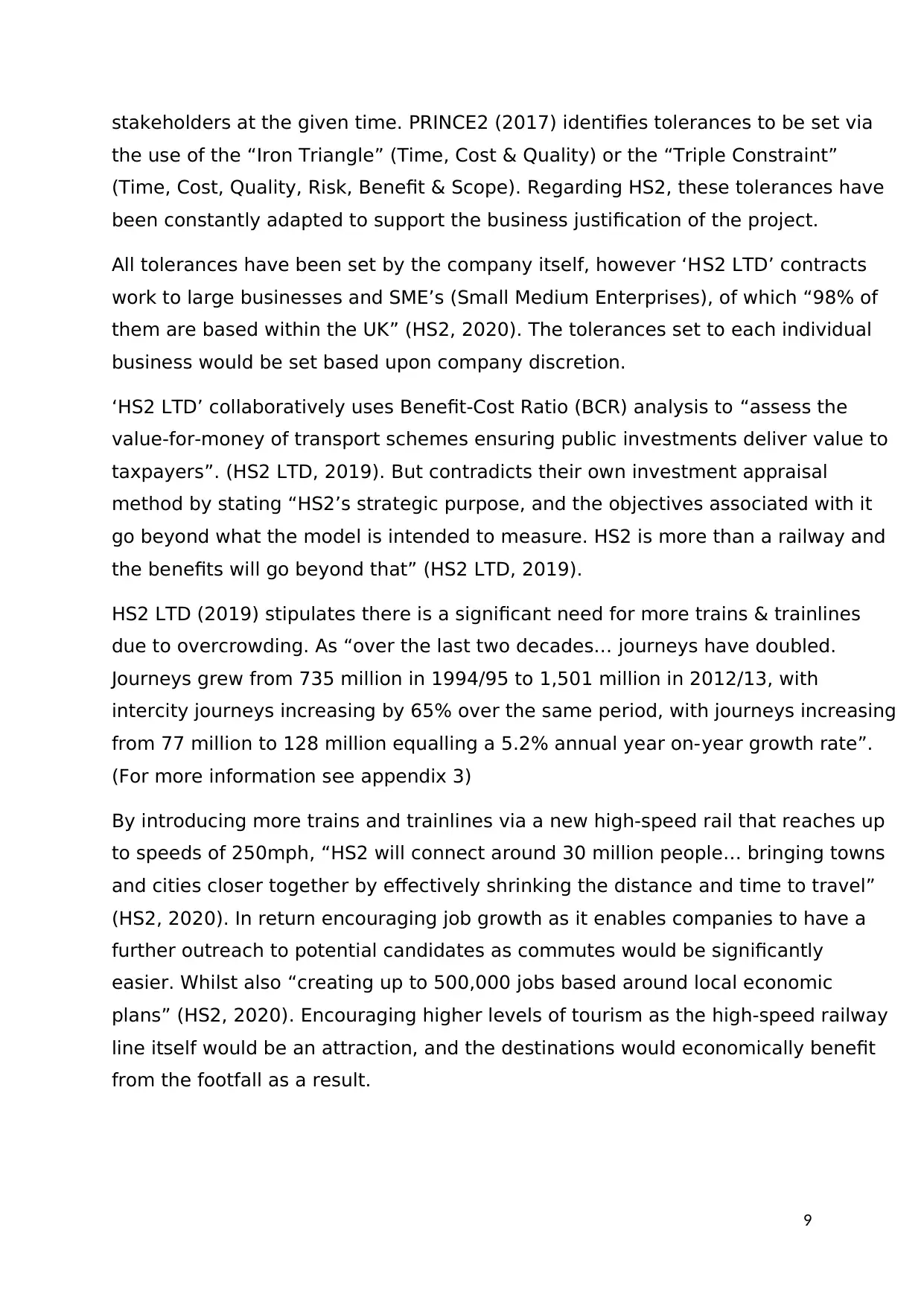
9
stakeholders at the given time. PRINCE2 (2017) identifies tolerances to be set via
the use of the “Iron Triangle” (Time, Cost & Quality) or the “Triple Constraint”
(Time, Cost, Quality, Risk, Benefit & Scope). Regarding HS2, these tolerances have
been constantly adapted to support the business justification of the project.
All tolerances have been set by the company itself, however ‘HS2 LTD’ contracts
work to large businesses and SME’s (Small Medium Enterprises), of which “98% of
them are based within the UK” (HS2, 2020). The tolerances set to each individual
business would be set based upon company discretion.
‘HS2 LTD’ collaboratively uses Benefit-Cost Ratio (BCR) analysis to “assess the
value-for-money of transport schemes ensuring public investments deliver value to
taxpayers”. (HS2 LTD, 2019). But contradicts their own investment appraisal
method by stating “HS2’s strategic purpose, and the objectives associated with it
go beyond what the model is intended to measure. HS2 is more than a railway and
the benefits will go beyond that” (HS2 LTD, 2019).
HS2 LTD (2019) stipulates there is a significant need for more trains & trainlines
due to overcrowding. As “over the last two decades… journeys have doubled.
Journeys grew from 735 million in 1994/95 to 1,501 million in 2012/13, with
intercity journeys increasing by 65% over the same period, with journeys increasing
from 77 million to 128 million equalling a 5.2% annual year on-year growth rate”.
(For more information see appendix 3)
By introducing more trains and trainlines via a new high-speed rail that reaches up
to speeds of 250mph, “HS2 will connect around 30 million people… bringing towns
and cities closer together by effectively shrinking the distance and time to travel”
(HS2, 2020). In return encouraging job growth as it enables companies to have a
further outreach to potential candidates as commutes would be significantly
easier. Whilst also “creating up to 500,000 jobs based around local economic
plans” (HS2, 2020). Encouraging higher levels of tourism as the high-speed railway
line itself would be an attraction, and the destinations would economically benefit
from the footfall as a result.
stakeholders at the given time. PRINCE2 (2017) identifies tolerances to be set via
the use of the “Iron Triangle” (Time, Cost & Quality) or the “Triple Constraint”
(Time, Cost, Quality, Risk, Benefit & Scope). Regarding HS2, these tolerances have
been constantly adapted to support the business justification of the project.
All tolerances have been set by the company itself, however ‘HS2 LTD’ contracts
work to large businesses and SME’s (Small Medium Enterprises), of which “98% of
them are based within the UK” (HS2, 2020). The tolerances set to each individual
business would be set based upon company discretion.
‘HS2 LTD’ collaboratively uses Benefit-Cost Ratio (BCR) analysis to “assess the
value-for-money of transport schemes ensuring public investments deliver value to
taxpayers”. (HS2 LTD, 2019). But contradicts their own investment appraisal
method by stating “HS2’s strategic purpose, and the objectives associated with it
go beyond what the model is intended to measure. HS2 is more than a railway and
the benefits will go beyond that” (HS2 LTD, 2019).
HS2 LTD (2019) stipulates there is a significant need for more trains & trainlines
due to overcrowding. As “over the last two decades… journeys have doubled.
Journeys grew from 735 million in 1994/95 to 1,501 million in 2012/13, with
intercity journeys increasing by 65% over the same period, with journeys increasing
from 77 million to 128 million equalling a 5.2% annual year on-year growth rate”.
(For more information see appendix 3)
By introducing more trains and trainlines via a new high-speed rail that reaches up
to speeds of 250mph, “HS2 will connect around 30 million people… bringing towns
and cities closer together by effectively shrinking the distance and time to travel”
(HS2, 2020). In return encouraging job growth as it enables companies to have a
further outreach to potential candidates as commutes would be significantly
easier. Whilst also “creating up to 500,000 jobs based around local economic
plans” (HS2, 2020). Encouraging higher levels of tourism as the high-speed railway
line itself would be an attraction, and the destinations would economically benefit
from the footfall as a result.
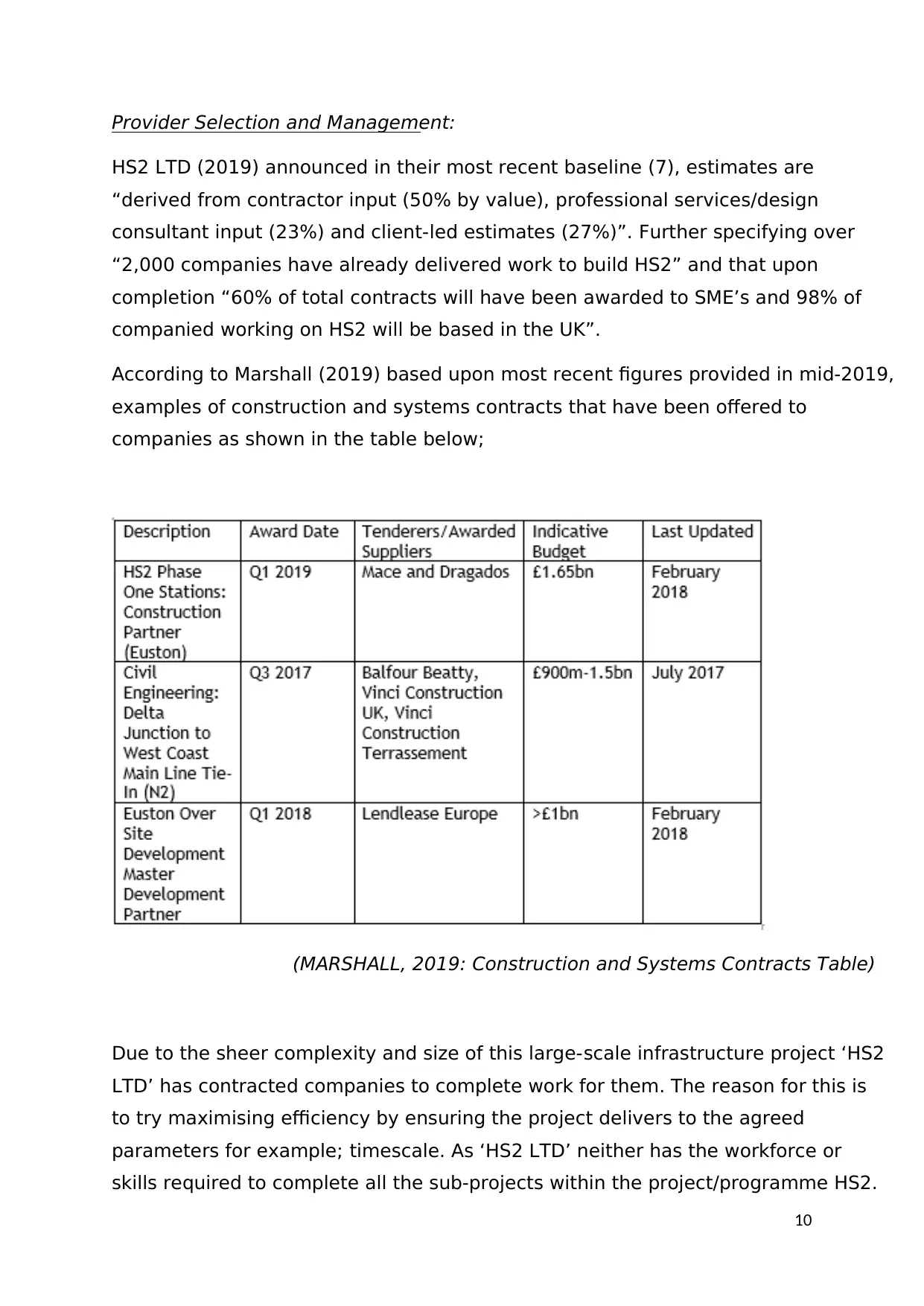
10
Provider Selection and Management:
HS2 LTD (2019) announced in their most recent baseline (7), estimates are
“derived from contractor input (50% by value), professional services/design
consultant input (23%) and client-led estimates (27%)”. Further specifying over
“2,000 companies have already delivered work to build HS2” and that upon
completion “60% of total contracts will have been awarded to SME’s and 98% of
companied working on HS2 will be based in the UK”.
According to Marshall (2019) based upon most recent figures provided in mid-2019,
examples of construction and systems contracts that have been offered to
companies as shown in the table below;
(MARSHALL, 2019: Construction and Systems Contracts Table)
Due to the sheer complexity and size of this large-scale infrastructure project ‘HS2
LTD’ has contracted companies to complete work for them. The reason for this is
to try maximising efficiency by ensuring the project delivers to the agreed
parameters for example; timescale. As ‘HS2 LTD’ neither has the workforce or
skills required to complete all the sub-projects within the project/programme HS2.
Provider Selection and Management:
HS2 LTD (2019) announced in their most recent baseline (7), estimates are
“derived from contractor input (50% by value), professional services/design
consultant input (23%) and client-led estimates (27%)”. Further specifying over
“2,000 companies have already delivered work to build HS2” and that upon
completion “60% of total contracts will have been awarded to SME’s and 98% of
companied working on HS2 will be based in the UK”.
According to Marshall (2019) based upon most recent figures provided in mid-2019,
examples of construction and systems contracts that have been offered to
companies as shown in the table below;
(MARSHALL, 2019: Construction and Systems Contracts Table)
Due to the sheer complexity and size of this large-scale infrastructure project ‘HS2
LTD’ has contracted companies to complete work for them. The reason for this is
to try maximising efficiency by ensuring the project delivers to the agreed
parameters for example; timescale. As ‘HS2 LTD’ neither has the workforce or
skills required to complete all the sub-projects within the project/programme HS2.
⊘ This is a preview!⊘
Do you want full access?
Subscribe today to unlock all pages.

Trusted by 1+ million students worldwide
1 out of 27
Your All-in-One AI-Powered Toolkit for Academic Success.
+13062052269
info@desklib.com
Available 24*7 on WhatsApp / Email
![[object Object]](/_next/static/media/star-bottom.7253800d.svg)
Unlock your academic potential
Copyright © 2020–2025 A2Z Services. All Rights Reserved. Developed and managed by ZUCOL.